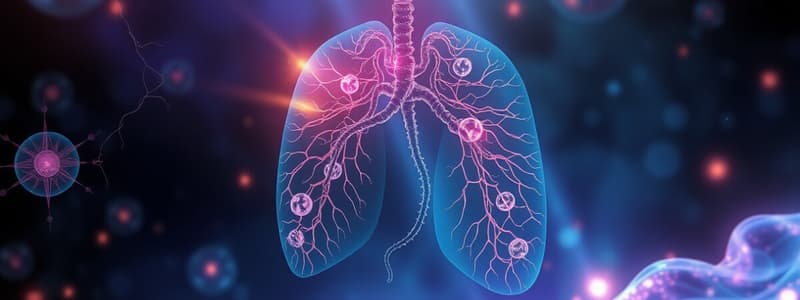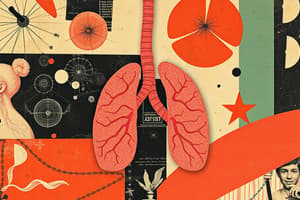Podcast
Questions and Answers
Which of the following is not a stage of cellular respiration?
Which of the following is not a stage of cellular respiration?
- Fermentation (correct)
- Electron transport
- Krebs cycle
- Glycolysis
What is the correct sequence of events in cellular respiration?
What is the correct sequence of events in cellular respiration?
glycolysis, krebs cycle, electron transport
Which of the following is released during the Krebs cycle?
Which of the following is released during the Krebs cycle?
- Lactic acid
- Energy (correct)
- Air
- Oxygen
Cellular respiration uses one molecule of glucose to produce a net total at its most efficient?
Cellular respiration uses one molecule of glucose to produce a net total at its most efficient?
What is the equation for cellular respiration?
What is the equation for cellular respiration?
Cellular respiration releases energy by breaking down what?
Cellular respiration releases energy by breaking down what?
Why can´t glucose get into the mitochondria?
Why can´t glucose get into the mitochondria?
Which of these is a product of cellular respiration?
Which of these is a product of cellular respiration?
What cellular respiration process takes place in the cytoplasm of the cell?
What cellular respiration process takes place in the cytoplasm of the cell?
Glycolysis provides a cell with a net gain of what?
Glycolysis provides a cell with a net gain of what?
The starting molecule for glycolysis is what?
The starting molecule for glycolysis is what?
Glycolysis requires _____________
Glycolysis requires _____________
Which of the following is not a product of glycolysis?
Which of the following is not a product of glycolysis?
Lactic acid fermentation occurs in what?
Lactic acid fermentation occurs in what?
During lactic acid fermentation, ex (a runner running at fast pace)?
During lactic acid fermentation, ex (a runner running at fast pace)?
Why is cellular respiration called an aerobic process?
Why is cellular respiration called an aerobic process?
Before starting the Krebs cycle, the starting molecule is called __________ in the mitochondrial membrane.
Before starting the Krebs cycle, the starting molecule is called __________ in the mitochondrial membrane.
What is the formula for adenine, a base in ATP?
What is the formula for adenine, a base in ATP?
The starting molecule for the Krebs cycle is a two-carbon molecule called?
The starting molecule for the Krebs cycle is a two-carbon molecule called?
The first few seconds of intense exercise uses up the cell's stores of (fat) _________
The first few seconds of intense exercise uses up the cell's stores of (fat) _________
Glycolysis converts glucose into two molecules of what?
Glycolysis converts glucose into two molecules of what?
If two pairs of electrons attach to an NAD+ and become NADH and they move down the electron transport chain, they will provide enough energy to produce (at most) ____________________ ATP molecules
If two pairs of electrons attach to an NAD+ and become NADH and they move down the electron transport chain, they will provide enough energy to produce (at most) ____________________ ATP molecules
Oxaloacetic acid is a 4C molecule (inside) the Krebs cycle.
Oxaloacetic acid is a 4C molecule (inside) the Krebs cycle.
In the preparatory phase, how many CO2 are released total over two cycles?
In the preparatory phase, how many CO2 are released total over two cycles?
The Krebs cycle does not occur if _______.
The Krebs cycle does not occur if _______.
Breathing heavily after running a race is your body's way of ___________
Breathing heavily after running a race is your body's way of ___________
Glycolysis provides a cell with a net gain of what?
Glycolysis provides a cell with a net gain of what?
Glycolysis requires an input of what?
Glycolysis requires an input of what?
What are the two main types of fermentation?
What are the two main types of fermentation?
The Krebs cycle produces what?
The Krebs cycle produces what?
During lactic acid fermentation, what happens?
During lactic acid fermentation, what happens?
In eukaryotes, the Krebs cycle takes place in the what?
In eukaryotes, the Krebs cycle takes place in the what?
Flashcards are hidden until you start studying
Study Notes
Cellular Respiration Overview
- Cellular respiration consists of multiple stages: glycolysis, Krebs cycle, and electron transport.
- Fermentation is not a stage of cellular respiration.
Sequence of Events
- The correct order of processes in cellular respiration is glycolysis, followed by the Krebs cycle, and then electron transport.
Energy Production
- Energy is released during the Krebs cycle.
- A molecule of glucose can yield a maximum of 38 ATP molecules through cellular respiration.
Chemical Equation
- The equation for cellular respiration is:
C6H12O6 + 6 O2 → energy + 6 CO2 + 6 H2O.
Glucose Breakdown
- Cellular respiration breaks down food molecules to release energy.
- Glucose cannot directly enter mitochondria; it is first converted into pyruvic acid.
Products of Cellular Respiration
- Water is a product of cellular respiration, while oxygen, glucose, and carbon dioxide are not products.
Glycolysis Details
- Glycolysis occurs in the cytoplasm and provides a net gain of 2 ATP molecules.
- The starting molecule for glycolysis is glucose, which requires an energy input to begin.
Glycolysis Products
- Products of glycolysis include NADH and pyruvic acid, but glucose is not a product after the reaction.
Types of Fermentation
- Lactic acid fermentation occurs in muscle cells and is accompanied by the regeneration of NAD+ to allow glycolysis to continue.
Aerobic Process
- Cellular respiration is classified as an aerobic process because it requires oxygen.
Krebs Cycle Initiation
- Acetyl-CoA is the starting molecule for the Krebs cycle, which takes place after glycolysis.
ATP Utilization
- The first few seconds of intense exercise utilize ATP stored in cells.
- Glycolysis converts glucose into two molecules of pyruvic acid.
Electron Transport Chain
- Electrons carried by NADH along the electron transport chain can produce up to 6 ATP molecules.
Krebs Cycle Characteristics
- Oxaloacetic acid is a 4-carbon molecule involved in the Krebs cycle.
- Two CO2 molecules are released in the preparatory phase of the Krebs cycle across two cycles.
- The Krebs cycle cannot proceed if fermentation is occurring.
Oxygen Debt
- Breathing heavily post-exercise is the body's mechanism for repaying oxygen debt.
Main Types of Fermentation
- The two primary forms of fermentation are alcoholic fermentation and lactic acid fermentation.
Electron Carriers
- The Krebs cycle produces electron carriers which are crucial for the electron transport chain.
Recap on NAD+ Regeneration
- During lactic acid fermentation, NAD+ is regenerated, enabling glycolysis to continue producing ATP.
Studying That Suits You
Use AI to generate personalized quizzes and flashcards to suit your learning preferences.




